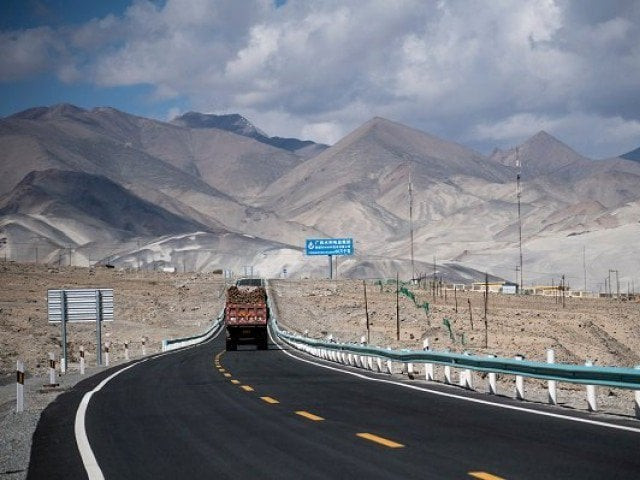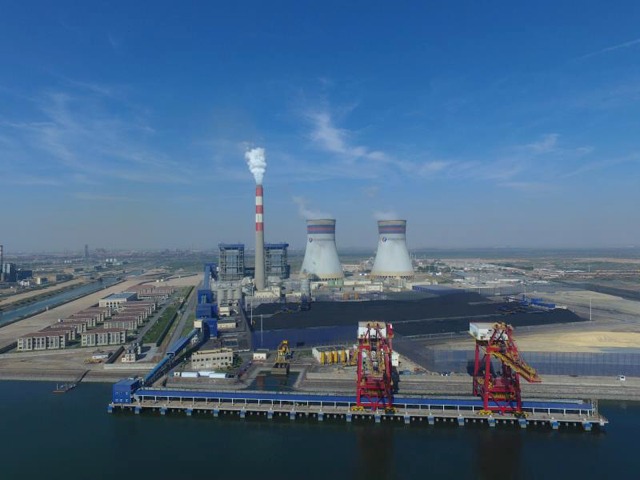Past five years of CPEC in review
Exploring impact and prospects of China-Pakistan Economic Corridor for Pakistan

PHOTO: REUTERS
Practices in the past five years have proved that the CPEC construct is not targeted at specific regions or groups, but is aimed at the whole country of Pakistan and benefits all the people of Pakistan.
- Fruitful achievements in CPEC construction
CPEC has played a flagship leading and demonstration role in the Belt and Road construction. It has become a platform for all-round pragmatic cooperation between China and Pakistan.
Improving macroeconomic conditions in Pakistan
CPEC has driven the development of Pakistan. The two-gap model proposed by economist Hollis B Chenery posits that developing countries must introduce foreign investments and stimulate exports to boost growth of their national economy. CPEC has solved the problem of limited investment capacity caused by insufficient savings and shortage of foreign exchange in Pakistan and provided a high-quality source of impetus for Pakistan's economic development. As of January 2019, CPEC included nine completed early harvest projects and 13 projects under construction, with a total investment of $19 billion. It drove Pakistan's economic growth by one to two percentage points every year and created 70,000 jobs in Pakistan. The Chinese government provided $5.874 billion in concessional loans to Pakistan, with a consolidated interest rate of only 2%, far lower than the average interest rate. The Chinese government also provided $143 million in interest-free loans for the Gwadar East-Bay Expressway project and free assistance for some livelihood projects in Pakistan.
Thanks to favourable factors such as the CPEC construction, Pakistan's macroeconomic conditions have been improving and its economy has maintained a momentum of rapid growth. Over the past five years, Pakistan's GDP grew by an average of 4.77%, especially in the 2017-2018 fiscal year, when Pakistan's GDP grew by 5.8%, the highest rate in recent 13 years. Pakistan's annual foreign direct investment grew from $650 million to $2.2 billion, and the per capita annual income rose from $1,334 to $1,641.
Alleviating Pakistan's energy shortage
Energy shortage is a hard nut to crack that restricts the economic development of Pakistan. It is a problem that previous Pakistani governments attached great importance to and most wanted to solve. The electricity gap cost Pakistan an annual average loss of $13.5 billion in GDP, according to a study by PwC in 2012. Power shortage left Pakistan in the dark for a long time, with rolling blackouts across the country lasting about 10 hours a day in major cities and up to 22 hours in rural areas.
CPEC has regarded the alleviation of energy shortage in Pakistan as one of the important areas of construction since its launch. Currently, 12 projects with a total installed capacity of 7,240MW have been started or put into operation. Through five years of construction, energy projects under the CPEC framework added 3,340MW of electricity to Pakistan by early April 2019, accounting for 11% of the country's total installed electricity capacity, thus greatly alleviating the power shortage in Pakistan.
In addition to power generation projects, China built the Matiari–Lahore ±660kV HVDC Transmission Line Project in Pakistan – the second HVDC transmission line in the world – to address the aging of Pakistan's power grid.
 PHOTO:FILE
PHOTO:FILEImproving infrastructure connectivity in Pakistan
The China Pakistan cross-border economic belt, linked by the China-Pakistan Karakoram Highway, has taken shape under CPEC. Through international logistics nodes such as Gwadar Port, Karachi and Peshawar, Pakistan serves to transport products from western China to countries in the Middle East and the Indian Ocean via transit transport. Therefore, infrastructure connectivity is also one of the important areas in the early harvest projects of CPEC.
The Karakoram Highway Phase 2 (Havelian–Thakot section) is 118.124 km long, including 39.305 km of expressway and 78.819 km of secondary highway. The project officially started on September 1, 2016. Currently, more than half of the project has been completed.
The section from Sukkur, Sindh in the south to Multan, Punjab in the north, of the Karachi-Peshawar Expressway, is 392 km long, with a total investment of $2.89 billion. The construction was undertaken by China State Construction Engineering Corporation. The project officially started in August 2016. The 33-km section from Multan to Shujabad was opened to traffic 15 months ahead of schedule on May 26, 2018. The entire Sukkur-Multan section is expected to be open to traffic in August 2019. The Karachi–Peshawar Expressway is designed with six lanes in two directions and a speed of 120 km/h. It will greatly improve the traffic in the two cities upon completion.
The Lahore Orange Line rail transit project was put into trial operation on October 8, 2017. The line is 25.58km long and is organised into five carriages, each carrying 200 passengers. The train starts from Ali Town and terminates at Dera Gujran. The total distance is covered in 45 minutes with stops on 14 stations, compared with 2.5 hours of road travel between the two places. According to the design plan, the Orange Line will have a capacity of 250,000 passengers per day at the beginning of operation, which will be further increased to 500,000 passengers per day by 2025.
Over the past five years, 51,000 direct jobs were created in the road infrastructure sector under CPEC projects, of which 48,000 were created specifically for local Pakistanis. Further, infrastructure projects are expected to spur the development of Pakistan's building-related industries and attract more foreign investment.
Gwadar Port on the fast track
Gwadar Port has taken on a new look in the past five years. The port roads, storage yards, loading and unloading equipment, seawater desalination, oil supply and port monitoring facilities have been further improved. Five new container bridge cranes; 100,000-m2 storage yards; container scanning equipment; the 220,000-gal desalination plant; two sewage treatment systems; 80,000-m2 new green space; and the new LPG receiving station have made the port capable of handling bulk cargo, containers, roll-on roll-off cargo and LPG. The container liner service was officially launched at Gwadar Port on March 7, 2018. The Gwadar-Middle East Express was opened, connecting Gwadar with other major ports in the world.
The Gwadar Port Free Trade Zone covers an area of 923 hectares and is constructed in four phases in two zones, one north and one south. On January 28, 2018, the Gwadar Free Zone Phase 1 was formally completed and put into operation, and the investment attraction was also completed simultaneously. More than 30 Chinese and Pakistani enterprises, including hospitality, banking, insurance, financial leasing, logistics, overseas warehousing, grain and oil processing, fishery processing and home appliance assembly, started working at the free zone. The direct investment exceeded RMB three billion. These enterprises will accomplish the annual output value of over RMB five billion and create more than 5,000 jobs after all being put into operation.
The Gwadar Faqeer Primary School, which was completed in September 2016, has developed rapidly, with a planned enrolment of 150 students and an actual enrolment of 500 students. The school achieved a pass rate of over 95% in the spring student examination in 2019, making it the best school in Balochistan in terms of teaching quality. In May 2017, the China-Pakistan Fraternity Emergency Care Centre assisted by the Red Cross Society of China was completed in Gwadar Port. The Chinese Red Cross Foundation sent three medical teams to work in the region. By the end of 2018, the centre received 2,302 Chinese and Pakistani patients.
The desalination plant for the Gwadar Free Zone was completed and put into operation in 2018, with a daily production capacity of 1,000 tons of drinking water. Gwadar's population grew from 60,000 to 130,000 in just five years.
 PHOTO: FILE
PHOTO: FILECross-border fibre optic project completed and opened
The 820-km China-Pakistan Cross-Border Fibre Optic Project, which is laid between the city of Rawalpind, Pakistan in the south and the Khunjerab Pass, China in the north, was completed and opened on July 13, 2018.
- Promising future of CPEC construction
2018 was an election year for Pakistan, when there was concern at home and abroad about whether Pakistan's attitude towards CPEC would change due to the change of government. Around the same time, there were some international opinions questioning CPEC, saying that a large amount of Chinese loans might plunge Pakistan into debt crisis. Facts over the past year have proved that the determination to build CPEC has not been shaken by the change of government in Pakistan and the debt crisis theory has been in tatters. In promoting the CPEC construction, China has always followed the principle of consultation, contribution and shared benefits, and given top priority to Pakistan's economic development and the vital interests of the Pakistani.
Based on Pakistan's future economic and social development priorities and people's needs, the future development path and cooperation direction of CPEC will be determined through consultation, with priority given to accelerating cooperation in industries, parks and agriculture, creating jobs, and improving people's livelihood.
Steadfast determination to build CPEC
At the very beginning of the new Pakistani government, Foreign Minister Shah Mehmood Qureshi said, “The new Pakistani government is advancing an ambitious reform agenda, and is willing to learn from China's experience in economic development, poverty alleviation, disaster reduction, anti-corruption, and environmental protection. Advancing CPEC is our top priority.”
From November 2 to 5, 2018, Prime Minister Imran Khan made his first official visit to China and attended the first China International Import Expo in Shanghai. During his visit, the two countries reached important consensus and signed a joint statement on further strengthening China-Pakistan all-weather strategic cooperative partnership and building a closer China Pakistan community of shared future in the new era.
Prime Minister Imran made it clear that the completed projects of CPEC are in the interest of Pakistan and will bring enormous social and economic development opportunities to the Pakistani people. Since China has lifted more than 700 million people out of poverty in the past decades, Pakistan is willing to learn from the Chinese government's poverty alleviation and reduction measures. Pakistan also hopes to strengthen cooperation in industry and agriculture to help unleash its greater development potential.
On March 20, 2019, China and Pakistan held the first strategic dialogue between foreign ministers and reached broad consensus. Qureshi noted that the Pakistani people are committed to promoting CPEC construction and expanding bilateral cooperation in various fields. State Councillor Wang Yi said that the CPEC project is expected to be expanded to a larger scope, including the western region, in Pakistan, according to the vision plan of CPEC construction agreed by both sides.
Fallacy of smearing CPEC debunked
Since the beginning of CPEC, rumours discrediting the project have been rampant. Some with ulterior motives accuse the mega project of exacerbating Pakistan's economic risks and claim that the country is falling into a "debt trap." The proportion of CPEC is very low in the foreign debt structure data released by the Pakistani government, which is not the cause of the debt problem of Pakistan at all.
More than 80% of the CPEC projects are funded by Chinese direct investment or use Chinese free assistance, while less than 20% use Chinese loans. "Instead of burdening Pakistan, CPEC has helped to boost its economy." In the next stage of CPEC development, cooperation will be strengthened with focus on people's livelihood. China will give more assistance to Pakistan in areas such as agriculture, education, medical care and drinking water. As the Pakistani people continue to reap tangible benefits from the achievements in CPEC construction and witness positive changes in their daily lives, the above rumours are debunked.
 PHOTO: FILE
PHOTO: FILEClear priorities of CPEC cooperation
As the CPEC construction is advancing, Pakistan's energy problem has been lessened dramatically, and the improvement in transportation infrastructure has laid a foundation for the industrial upgrading of Pakistan. Industrial cooperation will be the focus of the CPEC construction and development in the next stage, which will inject new impetus into the sustainable development of CPEC.
PM Imran noted that CPEC offers a "golden opportunity" for Pakistan to revitalise its economy and achieve development. The fundamental reason is that CPEC can significantly enhance the overall competitiveness of Pakistan. In terms of China Pakistan industrial cooperation, China should, on the one hand, focus on China Pakistan industrial parks to enhance their industrial capacity and economic strength. On the other hand, China should encourage Chinese enterprises to take an active part in Pakistan's existing and mature industrial parks and mobilise the enthusiasm of Pakistan's national capital.
With "Made in Pakistan" as a breakthrough point, China will help accelerate the development of Pakistan's local industries, and promote export and import substitution of high value-added products, so as to make Pakistan's existing parks grow stronger.
Cooperation in agriculture will be deepened. 70% of Pakistan's population lives in rural areas, and is dependent on land. China's advanced agricultural technology and farming equipment will improve the agricultural production efficiency of Pakistan and increase the added value of agricultural products, so as to lift the farmers out of poverty. Given the dilemma of high inflation, currency devaluation and insufficient foreign exchange reserves in Pakistan in recent years, the development of agriculture will also help Pakistan increase foreign exchange income and realise international balance of payment.
The second textile expo was held in Lahore, Pakistan from April 11 to 14, 2019. Pakistan's textile industry accounts for 60% of the country's total exports, and Pakistan is one of the few countries in the world with a complete textile industry chain. The expo means a good opportunity for the development of Pakistani textile enterprises. Additionally, the second Gwadar Expo was successfully held on March 28 and 29, 2019. It attracted more than 200 exhibitors from China and Pakistan, and they signed cooperation agreements in shipping logistics, agriculture, animal husbandry, Muslim food processing and so on.
The new Pakistani government attaches great importance to the development of people's livelihood and aims to shape Pakistan into a just welfare state. CPEC, consistent with the local situation, has particularly given priority to benefiting the people. Energy projects have been completed to meet the needs of approximately 8.6 million households. The primary schools and China Pakistan medical centres near Gwadar have improved the education and medical conditions of the local people.
In the future, the two countries are expected to sign a series of agreements covering areas related to people's livelihood, including education, health, agriculture, water for irrigation, poverty alleviation, and human resources development. Hospitals have been set up in Khyber-Pakhtunkhwa and Balochistan, and vocational and technical training colleges have been established throughout Pakistan.
- New challenges to CPEC construction
Currently, CPEC construction has gradually shifted from energy and transportation infrastructure cooperation to industrial cooperation and industrial park construction. PM Imran has given prominence to promoting industrialisation and employment in Pakistan, and laid greater emphasis on the western route of CPEC. Meanwhile, the international situation has also changed. Given the overall situation, we should be clear that old challenges have not yet subsided and new ones are emerging in the CPEC construction.
First, the complex international political situation, especially the interference of external factors on CPEC, cannot be ignored.
Second, Pakistan has a serious fiscal deficit, a huge foreign debt and a heavy debt service burden. The capacity to provide supporting funds for CPEC construction has declined sharply and it is no longer feasible to expand infrastructure construction. Pakistan's new government wants to rein in huge capital spending, especially on projects that require large amounts of foreign exchange.
Third, the overall security situation in Pakistan has improved year by year, but terrorist attacks still occur frequently. Over the past year, violent and terrorist attacks launched by Balochistan separatists occurred frequently, with changes in form, geographical expansion and new features, and the threat to Gwadar Port and CPEC has increased.
Despite many challenges to the CPEC construction, it is the internal factors that are the root cause affecting the CPEC construction. When we realise and successfully eliminate the internal negative factors, external factors cannot really affect the process of CPEC construction.
The writer is a professor at the Centre for Pakistan Studies of Peking University, China



















COMMENTS
Comments are moderated and generally will be posted if they are on-topic and not abusive.
For more information, please see our Comments FAQ